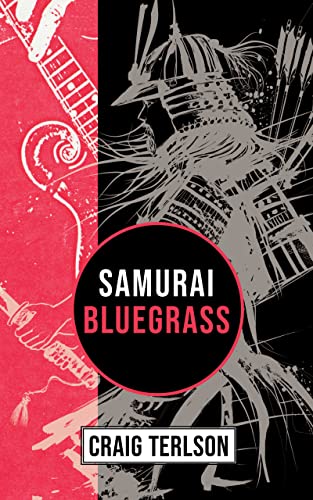A Review of Craig Terlson’s Samurai Bluegrass
By Ashley Holloway
Samurai Bluegrass, the latest from prolific author Craig Terlson, set to be released in July 2023 by Literary Wanderlust, is an action-packed tale of a time-traveling samurai who finds himself in 1984 Toronto. Combining such disparate things such as samurai and bluegrass in a work of fiction is a bold endeavor. However, Terlson successfully weaves them together into an entertaining, gripping page-turner.
Though written from a first-person narrative, it could be argued there are two protagonists in this story. Gordo Clement, the first-person narrator and the body inhabited by the time-traveling samurai is one. But there’s also single-mom Heather, who’s trying to make ends meet as an illustrator. At surface level, this dichotomy seems equally as disparate as combining bluegrass and ancient samurai together. However, Terlson presents a balanced and well-paced story where the characters, as contrasting as they are, simply work.
After being killed by archers in 12th century Japan, the samurai finds himself transported to a forest in 1984 Toronto, into the body of a red-headed white man, Gordo. He soon realizes the connection between music and the ability to cross over in time when he attends a bluegrass concert with friends he recently made. It is on this same night that Gordo is first introduced to Heather, and thus begins their curious relationship. Thankfully, Terlson resists succumbing to stereotypical storylines and keeps their relationship platonic in nature, which results in a richer storyline that focuses on the characters themselves rather than simply on the plot.
As the story unfolds, the reader is transported between 1984 Toronto and 12th century Japan through Gordo’s mirthful narration and inner monologue. Being privy to Gordo’s thoughts as he describes the idiosyncrasies of modern day living in comparison to ancient Japan is a brilliant reminder of how context shapes the way people think and behave, as well as the importance of finding connection with others. This juxtaposition of being physically similar to the vast majority, yet nevertheless feeling like an outsider is an effective strategy to highlight how it feels to be an “other.” Serving as the prominent theme of the book, the need for belonging, particularly when one is aware they do not belong, is an effective reminder of the human tendency to create divisiveness and its ensuing costs.
Struggling to balance living in a new and strange world with hiding his true identity from others, Gordo has limited success. At times his samurai instincts prevail in moments of danger, yet this threatens to reveal the story of his identity. Living in a constant state of hypervigilance and unsure of who to trust, Gordo recognizes the need to accept help from others in order to get home. This counterbalance is revealed through Gordo’s inner monologue, generating a healthy dose of tension and leaves the reader rooting for Gordo to succeed.
Running parallel to Gordo’s story is Heather’s narrative. She’s a struggling illustrator who recently moved to Toronto with her 10-year-old son Zach. Coming to big city Toronto from a small town, Heather soon realizes what it feels like to not belong. Finding herself suddenly entwined in Gordo’s life after he saves her from being attacked in a dark alley one night, the reader learns her story in bite-sized pieces as she navigates this separate storyline. As a character, Heather faces it all: single mother, struggling artist, a parasitic ex-boyfriend (though he does have a few redeeming qualities), and an ailing father who lives elsewhere, and yet Terlson effectively creates her as the epitome of strength, rather than a target for pity.
Crossing paths again in the street by coincidence after their initial introduction in the dark alley where Gordo saves her from these salacious thugs, Heather is drawn to Gordo, actively seeking him out again after his heroic actions stirred her curiosity and creativity. Gordo finds a kindred spirit in her through their common feeling of being outsiders, he eventually opens up about his story which further solidifies their relationship and combines their parallel stories into one. In doing so, Gordo, accustomed to his solitary samurai life, soon realizes the importance of connection.
Of course, there is an antagonist in the form of a fellow time-traveler, called the Doctor, who serves as the main point of conflict in this story. The Doctor, whose character is a stereotypical villain, evokes typical Hollywood-style images of an evil character in the mind’s eye. The reader immediately recognizes this malevolence through the physical descriptions of the Doctor as well as his inner monologue and thus dislikes him. Creating characters that elicit such emotion from the reader is a great strength of Terlson’s writing and adds to the readability of the story.
The presence of two time-travelers is the source of great conflict in the story, as for one to travel back home, the other must die, a fact only the Doctor is aware of. Tracking him down through various means, the Doctor initially introduces himself to Gordo as a healthcare professional who is treating him for a mental illness, using this as an excuse to lure Gordo into his trust. This generates a great deal of alarm in Gordo, as through his first “guide” he met after crossing over from 12’th century Japan, Harry, a homeless man, introduces this notion of mental illness being something to fear. While Gordo becomes wise to the Doctor’s ruse and uses his samurai skills to extricate himself from the situation, some readers may feel this inference acts as a subtle form of fear mongering towards mental illness. Instead, I would argue this serves to reinforce the underlying theme of how context shapes our thinking; Harry, being a trusted “guide” to Gordo, introduces this idea that mental illness, or more specifically, being seen as someone with a mental illness, is something to be feared. Gordo, as a vulnerable individual who places his trust in Harry, has no reason to think otherwise. Whether we live in 12th century Japan, 1984 Toronto, or todays’ world,, our ideas are shaped by the prevailing narrative we are exposed to, whether it’s accurate or not. Terlson illustrates this beautifully in this compelling story.
As Gordo starts to unravel the time-traveling mystery and its connection to music, he realizes the Doctor may hold the answer to Gordo returning home. The story’s intensity further increases after it is revealed that for him to return home, either him or the Doctor must die. This forces Gordo to rely on his inner samurai instincts to save himself and keep his friends, including Heather and her son, safe. This action-packed book reads a bit like a James Patterson novel combined with The Matrix, never stopping for even a breath.
From its opening line of “Every day I remained in the City, I thought of my death,” Terlson hooks the reader, maintaining this same sense of gritty intrigue right until the final pages. While the dialogue is a bit stiff in places, this aligns with the context of the story of being an outsider in an unforgiving world and all its ensuing awkwardness. Though nuanced at times, this theme is also further evidenced in places through the endearing dialogue such as, “You don’t sound Canadian. The way you speak is like someone from my country who had to learn a language. Like me.”
Also, with its excellent use of subtext and descriptive language, the reader is drawn into the well-researched story, emphasizing the delicate relationship between research and writing. Interestingly, Terlson skillfully uses a technique called “in-clueing,” where just enough information is supplied so the reader is satisfied; should they wish to engage in more research, Terlson has supplied the necessary breadcrumbs to do so. In contrast, there is also just enough research supplied within the storyline to allow the reader sufficient context to read straight through without any additional research. In presenting the story in this way, Terlson has successfully established narrative truth, creating a sense of trust with the reader that keeps them turning the pages. The historical aspects, the Japanese terminology used, as well as subtle details, such as Gordo’s Shona friend Vimbo are all factually correct, demonstrating a commitment to maintaining the fiction contract with the reader.
Finally, readers must remind themselves of the element of fantasy in this book when considering the many plot conveniences peppered throughout the story. While indeed convenient, they keep the momentum in forward motion, despite asking the reader to suspend their disbelief and not be surprised when the characters “just happen upon” each other at the perfect moment.
With its brilliant paralleling plots and subplots, this story is reminiscent of a false peak when hiking; just when it seems the summit is within reach, another peak is revealed. In the case of this story though, the false peaks are a delight and keep the reader turning pages. Samurai Bluegrass is an electrifying story that serves as the perfect summer read for readers who are looking for a fast-paced fantasy-thriller.


Ashley Holloway
Residing in Mohkinstsis, Ashley Holloway teaches healthcare leadership at Bow Valley College in Calgary, AB. She is a nurse with a Master of Public Health, a graduate diploma in Global Leadership, with further studies in intercultural communication and international development. Ashley’s work has appeared in the Calgary Public Library Short Story Dispenser, The Nashwaak Review, The Globe and Mail, Magna Publications, The Prairie Journal, CARE Magazine, Flash Fiction Magazine, Canadian Dimensions, with regular contributions to Lead Read Today; forthcoming publications include Flash Fiction Magazine (TBD), and WELL READ Magazine (March 2023). Ashley has co-authored two books (Create & Curate: 500 Ideas for Artists & Writers, 2023; and How (Not) to Lead, 2023) and reads manuscripts, writes book reviews, and provides editorial feedback for Unleash Press. Her work has been nominated for the Pushcart Prize.
